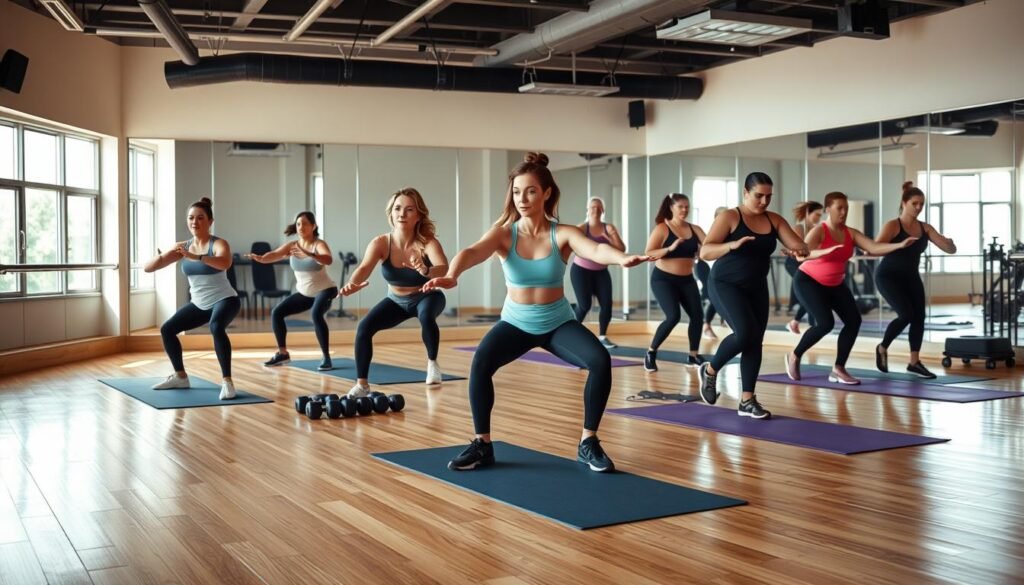Ever wondered why some people shed pounds faster while others struggle despite working out? The secret lies in choosing the right activities that maximize calorie burn while boosting overall health.
Physical activity does more than just help you slim down. Studies show it strengthens bones, lifts mood, and cuts chronic disease risks by 20%. Whether you prefer cardio or strength training, the right routine can transform your body and mind.
For lasting results, focus on workouts that balance intensity and recovery. A mix of movements keeps things fresh while targeting different muscle groups. Research proves even walking programs reduce body fat by 1.5% in just 12 weeks.
Key Takeaways
- Exercise boosts metabolism by 7.4-9% with strength training
- Cardio workouts lower chronic disease risks significantly
- Variety prevents boredom and ensures full-body conditioning
- Intensity and duration impact fat-burning efficiency
- Consistency delivers both physical and mental benefits
Introduction to Weight Loss Exercises
Not all workouts deliver the same fat-burning results—science reveals why. Your body’s energy use depends on exercise type, intensity, and even rest periods. To lose weight, you need a calorie deficit: burning 3,500 more than you eat sheds 1lb of body fat.

High-Intensity Interval Training (HIIT) outperforms steady cardio for efficiency. A 20-minute HIIT session can match 40 minutes of moderate cycling, according to studies. This happens because HIIT boosts your metabolic rate for hours post-workout.
Daily movement matters too. Non-Exercise Activity Thermogenesis (NEAT)—like walking or fidgeting—accounts for 10–20% of calories burned. Meanwhile, your Basal Metabolic Rate (BMR) uses 60–70% just to power basic bodily functions.
The CDC notes a 154lb person burns 145 calories in 30 minutes of cycling. But anaerobic exercise (like weightlifting) keeps burning fuel for up to 48 hours, while aerobic workouts stop when you do.
Combine strength and cardio with “exercise stacking” for better fitness results. But avoid losing more than 1% of body weight weekly. Faster loss risks muscle loss and harms long-term health.
1. Walking: A Simple Start for Beginners
Walking might seem basic, but it’s one of the most effective ways to kickstart your fitness journey. Unlike intense workouts, it requires no special skills—just a good pair of shoes and consistency. Research shows a 65kg person burns 7.6 calories per minute, while an 81kg individual torches 9.7 calories, making it scalable for all body types.

Calories Burned
Terrain matters. Urban walks with uneven sidewalks burn 15% more calories than treadmill sessions. Adding a 5% incline boosts burn by 32%, according to the American Council Exercise. A 12-week study found participants lost 1.5% body fat and trimmed 1.1 inches from their waists just by walking regularly.
Benefits
Beyond weight management, walking strengthens bones, cutting osteoporosis risk by 8%. It’s also gentle on joints and improves mood. For beginners, alternating 3 minutes of brisk walking with 1-minute recovery intervals maximizes fat loss without overexertion.
How to Get Started
Start with 30-minute walks three times weekly, progressing to 45 minutes five times a week. Invest in cushioned shoes and moisture-wicking clothes to prevent blisters. Track progress with a step tracker—10,000 steps burn roughly 400 calories for a 150lb person. Avoid overstriding, and always warm up to prevent injuries.
Remember: Small steps lead to big results. Walking isn’t just about losing weight—it’s about building sustainable habits.
2. Jogging or Running: Boost Your Calorie Burn
If you’re ready to ramp up your cardio, jogging and running offer unmatched fat-burning potential. These high-energy activities elevate your heart rate and metabolism, making them ideal for shedding body fat. Studies show a 65kg runner burns 13.2 calories per minute—22% more than jogging at 10.8 calories.

Calories Burned
Speed defines the difference: 6.4–9.7 km/h is jogging; beyond 9.7 km/h qualifies as running. Surface matters too. Grass or turf reduces injury risk by 28% compared to asphalt, though harder surfaces burn slightly more calories due to increased effort.
Benefits
Regular runners see a 12% drop in visceral fat—the dangerous kind surrounding organs. It also strengthens the heart and improves lung capacity. Aim for 170–180 steps per minute (cadence) to optimize efficiency and reduce joint strain.
Tips for Beginners
Start with walk-run intervals: 2 minutes jogging, 1 minute walking, repeating for 20 minutes. Over 8 weeks, transition to continuous jogging. Invest in a GPS watch to track pace and fitness progress. Reflective gear and anti-chafe products enhance safety and comfort.
Never increase weekly mileage by more than 10% to avoid injuries. Nasal breathing (inhale through nose, exhale through mouth) builds endurance. Consistency trumps intensity—three 30-minute sessions weekly yield better health results than sporadic long runs.
3. Cycling: Low-Impact Cardio
Pedaling your way to fitness offers a perfect blend of adventure and calorie-torching efficiency. Unlike high-impact workouts, cycling protects joints while elevating your heart rate, making it ideal for sustained weight management. Whether you prefer scenic trails or studio classes, this cardio staple adapts to all fitness levels.

Calories Burned
A 65kg cyclist burns 6.4 calories per minute at 16 km/h—enough to shed 1lb weekly with daily 45-minute rides. Push to 24 km/h, and expenditure jumps to 10.2 calories/minute. Road cycling’s variable terrain burns 22% more energy than stationary bikes, while spin classes maximize burn with controlled resistance intervals.
Benefits
Cycling preserves joints with 67% less impact than running, per sports medicine studies. It also boosts heart health, lowering resting pulse rates by 8% in 12 weeks. For explosive fat loss, try HIIT: 30-second sprints followed by 4-minute recovery cycles spike post-workout calories burned by 37%.
Indoor vs. Outdoor
Outdoor rides engage more muscle groups with wind resistance and hills. Indoor bikes like Peloton or Zwift offer virtual terrains and real-time metrics. Recumbent bikes suit mobility-limited individuals, while proper bike fit—knee micro-bends and relaxed shoulders—prevents strain. Always wear a helmet; they cut head injury risks by 70%.
4. Strength Training: Build Muscle, Burn Fat
Lifting weights does more than build muscle—it rewires your metabolism for long-term fat loss. Unlike cardio that burns calories only during the workout, resistance training keeps your furnace burning for up to 38 hours afterward through Excess Post-Exercise Oxygen Consumption (EPOC).
Calories Burned
A 6-month study showed regular strength training boosts resting metabolic rate by 7.4%, burning an extra 125 calories daily. Compound movements like squats trigger greater EPOC effects—burning 14-23% more post-workout calories than isolation exercises.
Benefits
Every pound of muscle gained burns 6-10 calories daily at rest. Heavy weights (70-85% 1RM) build more lean tissue than light weights with high reps. Tempo training (4-second lowers, 2-second lifts) increases time under tension by 300% for better results.
Postmenopausal women gain 1.3% bone density monthly with resistance exercise. The movement hierarchy matters: squats and deadlifts engage more muscle fibers than presses or rows.
Getting Started
Begin with bodyweight movements before progressing to bands and free weights. Aim for 1.6-2.2g of protein per kg of body weight to support muscle growth. Follow a 3-week strength block with 1-week deload for optimal recovery.
Limit sessions to 60 minutes with 48-hour rest between muscle groups. Remember: strength training isn’t just about appearance—it’s health insurance for your bones, joints, and metabolism.
5. Swimming: Full-Body Workout
Dive into a workout that challenges every muscle while being gentle on joints—swimming delivers both power and precision. Water’s resistance amplifies effort, turning laps into a dynamic cardio and strength session. Studies show it burns fat efficiently while protecting bones and tendons.
Calories Burned
Stroke choice impacts intensity. Breaststroke torches 150 calories in 10 minutes—50% more than freestyle. A 60-minute session three times weekly slashes triglycerides by 24%, per research. For max burn, try aquatic HIIT: 50m sprints with 30-second rests spike post-workout metabolism.
Benefits
Swimming boosts health holistically. It builds lung capacity and reduces joint stress by 67% versus running. The thermal effect—water conducts heat 25x faster than air—elevates calories burned. Regular swimmers report better sleep and lower body fat percentages.
Best Strokes for Weight Loss
Butterfly reigns as the most demanding, engaging shoulders and core intensely. Backstroke offers active recovery while toning arms. Use pull buoys to increase upper-body engagement by 40%. Beginners should progress from 25m laps to continuous mile swims, refining streamlined positions to cut drag by 15%.
For open-water swimmers, wetsuits add buoyancy but reduce mobility. Always rinse with chlorine-neutralizing shampoo post-pool to protect hair and skin. Swimming isn’t just exercise—it’s a lifelong skill that marries fitness with fluid grace.
6. Yoga and Pilates: Mindful Movement
Transform your workout routine with the mindful power of yoga and Pilates—where movement meets mental clarity. These disciplines blend strength, flexibility, and breath control to sculpt your body while reducing stress. Research shows 90 minutes of yoga twice weekly trims waistlines by 1.5 inches, and Pilates three times weekly slims hip circumference.
Calories Burned
Not all styles burn equally. A vigorous Vinyasa yoga session torches 120 calories in 30 minutes—33% more than gentle Hatha. Pilates reformers amplify resistance by 40% versus mat work, increasing energy expenditure. For context, a 150lb person burns ~180 calories in a 50-minute beginner class.
Benefits
Beyond calories, these practices enhance balance and proprioception—improvements last 48 hours post-session. Diaphragmatic breathing cuts cortisol by 27%, aiding stress relief. EMG data reveals Pilates plank variations engage the core 300% more than crunches.
Eight weeks of yoga reduces stress markers by 22%. But caution: Overstretching without strengthening risks joint instability. Pair flexibility work with resistance moves for optimal health.
Tips for Beginners
Start with props like blocks or straps to modify poses safely. Focus on form: Align knees over ankles in squats, and keep shoulders relaxed during Pilates roll-ups. For balance, try tree pose near a wall. Gradually progress to advanced flows like Ashtanga or reformer springboards.
Consistency matters more than intensity—two 45-minute sessions weekly yield better fitness gains than sporadic marathon practices. Listen to your body; discomfort is normal, pain is not.
7. Factors Affecting Weight Loss Results
Science reveals why two people doing identical workouts can achieve dramatically different weight loss results. Your genes control 40-70% of BMI variation, while sleep deprivation spikes cravings by 45%. These hidden variables explain why some lose weight effortlessly while others hit frustrating plateaus.
The body actively resists change through Set Point Theory—it defends against body fat fluctuations exceeding 10%. This survival mechanism once helped ancestors survive famines, but now works against modern health goals. Strategic nutrition can gently reset this threshold over time.
Key Influencers
Protein requires 20-30% of its calories just for digestion—the thermic effect of food. This makes high-protein diet plans 27% more effective for fat reduction than low-protein approaches. Your fork might be the most powerful tool for reshaping your metabolic rate.
After age 30, metabolism declines 3-8% per decade as muscle mass naturally decreases. Men maintain an advantage, burning 19% more calories at rest than women due to higher testosterone and lean tissue percentages. These biological differences require customized approaches.
DEXA scans provide accurate body fat measurements where BMI fails. The standard BMI chart misclassifies 25% of muscular individuals as overweight while missing dangerous visceral fat in “normal” weight individuals. Body composition testing reveals what scales hide.
Healthy Weight Loss Pace
Strategic refeed days with carb cycling prevent metabolic adaptation—a 2-day 20% calorie boost can restart stalled weight loss. This mimics ancestral feast-famine cycles, tricking the body into maintaining higher energy expenditure.
Extreme restriction backfires. Very Low Calorie Diets (body weight weekly preserves lean tissue while steadily reducing fat stores.
Remember: Sustainable health transformations account for biological individuality. Your perfect plan balances genetic realities with evidence-based strategies for lasting change.
Conclusion
Transforming your body starts with smart choices, not extreme measures. A balanced mix of cardio and strength training delivers lasting health benefits beyond the scale. Aim for 150 minutes of movement weekly, paired with two resistance sessions.
Celebrate non-scale victories like better sleep, lower blood pressure, and improved mood. Track progress with photos or performance metrics—small wins build momentum. Group classes or workout buddies can boost consistency by 38%.
Remember, even 10-minute sessions count. Use trusted resources like the ACE exercise library or NIH guidelines for safe routines. Start with one change, then build gradually. Sustainable fitness is a journey, not a sprint.
Your health matters most. Focus on feeling stronger, not just shedding pounds. Every step forward counts.
FAQ
How many calories can I burn by walking?
A 30-minute brisk walk can burn around 150-200 calories, depending on speed and body weight.
Is jogging better than walking for fat loss?
Jogging burns more calories per minute, but walking is gentler on joints. Both help, so choose based on fitness level.
Can cycling help reduce belly fat?
Yes, cycling engages core muscles and burns fat, but spot reduction isn’t possible—overall body fat decreases with consistency.
How often should I do strength training?
Aim for 2-3 sessions weekly, targeting all major muscle groups for balanced muscle growth and metabolism boost.
Which swimming stroke burns the most calories?
The butterfly stroke tops the list, but freestyle and breaststroke are also effective and easier to sustain.
Can yoga really help with weight loss?
Yes, styles like Vinyasa or Power Yoga elevate heart rate, while stress reduction may curb emotional eating.
Why isn’t the scale moving despite exercise?
Muscle gain, water retention, or diet gaps can mask fat loss. Track progress with measurements or how clothes fit.
What’s a safe weekly weight loss goal?
Losing 1-2 pounds per week is sustainable and reduces muscle loss, per the American Council on Exercise.



